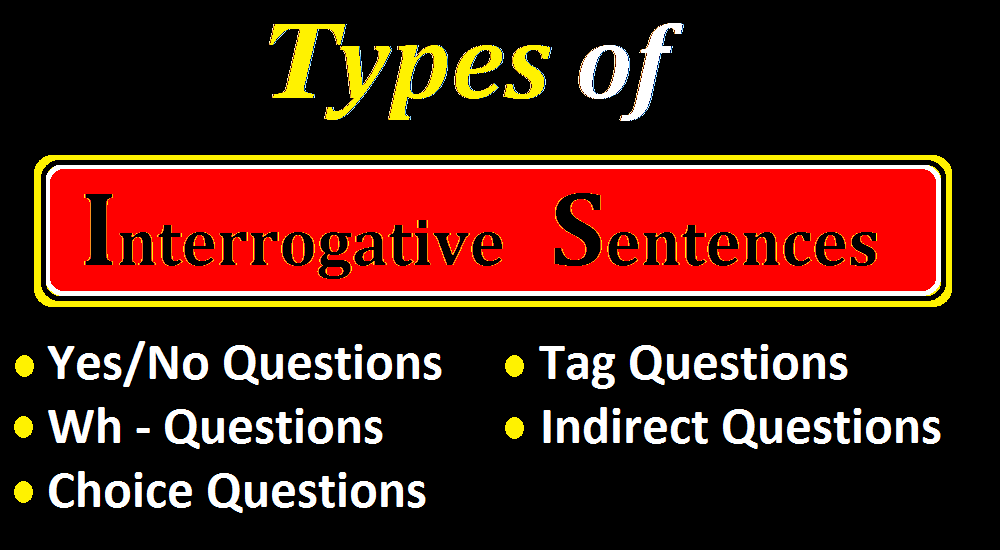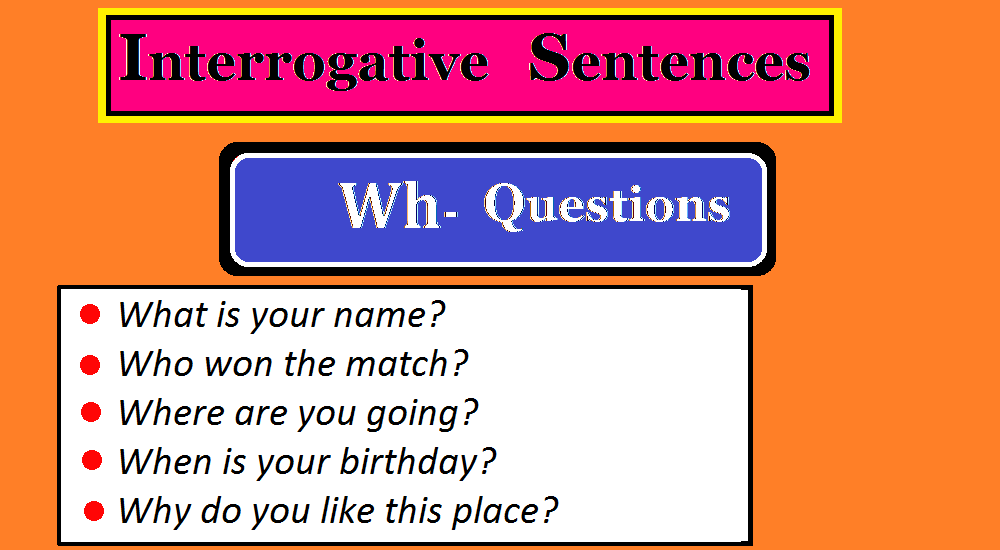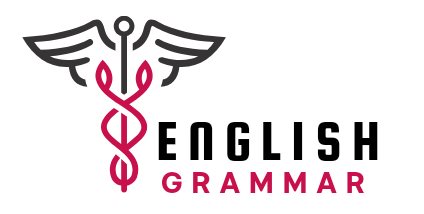Interrogative sentence is a type of sentence in English that asks a question and ends with a question mark (?), Types of Interrogative Sentences in English.

This article will go over the concept, interrogative sentence definition, structure, types, and examples.
Definition of the Interrogative Sentence In English:
An interrogative sentence is a kind of sentence in English grammar that asks a question to gather information and generate a conversation. They always stop with a question mark (?).
These sentences typically begin with question words, such as wh-words (who, what, when, where, why, who) and how, or auxiliary verbs (do, have, can, is, or will).
What Is Interrogative Sentence In English Grammar?
Interrogative sentences are used to ask the audience questions in order to obtain an answer or additional information. They generally end with a question mark. They can be as simple as asking someone’s name or as complex as asking about their opinions on various topics.
The structure of interrogative sentences allows you to communicate effectively in a variety of situations.
Helping Verb + Subject + Main Verb + Object?
The helping verb comes first, followed by the subject, and then the main verb. If there is an object, it follows the main verb. They can be as simple as asking someone’s name or as asking their opinion on various topics.
For Example:
- Which is your pick colour?
- How are you?
- Do you attend school?
- Where are you from?
- Where do you live?
In each of these statements, the interrogative language is used for asking information.
Types of Interrogative Sentences in English
There are five types of interrogative sentences in English grammar;
Yes/No Questions, Wh-Questions, Choice Questions, Tag Questions, and Indirect Questions.
In English, the formation of question sentences usually involves specific patterns, particularly regarding the place of the subject and the auxiliary verb.
1. Yes/No Questions
These are the simplest types of questions, expecting a “yes” or “no” answer.
Yes/No questions are straightforward and are usually formed by inverting the subject and the auxiliary or modal verb.

These questions usually begin with an auxiliary verb (such as am, is, are, do, does, did) or a modal verb (such as can, could, may, will). If there is no auxiliary verb, the “do” is used.
Structure of Yes/No Questions:
Yes/No Questions structure is as follows;
Auxiliary verb + subject + main verb + object?
In the formation of Interrogative sentences, understanding the yes/no questions formula will help you make the right question sentences. They are frequently easy to establish due to their simple structure.
Yes/No questions are easy to understand and demand only a “yes” or “no” response, making them an excellent approach to practice English conversation skills.
Examples of Yes/No Questions:
These questions sentences are useful for getting direct replies and verifying or denying specific facts.
Yes/No Questions examples of Interrogative sentences are the following;
- Are you coming to the party?
- Can you complete the project on time?
- Did he finish his homework?
- Do you like pizza?
- Can you swim?
- Do you know her?
- Did you call him?
- Have you seen this movie?
- Do you understand?
- Do you feel healthy today?
- Is it raining out?
- Are you from this city?
- Do you like to travel?
- Are you prepared for the test?
- Have you had dinner?
- Do you attend school?
- Can you speak Spanish?
- Do you prefer spicy foods?
- Have you brought your umbrella?
- Is the bank open on the weekends?
- Do you own a car?
- Is that your brother?
- Will it rain tomorrow?
Practicing with yes/no questions like these might help you improve confidence and relaxation in speaking and appreciating English.
2. Wh-Questions
They are called “Wh-Questions” because they usually start with “wh,” although “how” is an exception.

These sentences begin with questions with Wh-words such as (who, what, where, when, why, and how.
Structure of Wh-Questions:
The Wh-Questions structure is the following;
Wh- word + auxiliary verb + subject + main verb + object?
In the formation of interrogative sentences, understanding the wh-questions formula will help you make the right wh-question sentences. They are usually easy to recognize by their word structure.
Examples of Wh-Questions:
These questions are essential in English because they help gather information in a natural and conversational way. Wh-Questions examples of interrogative sentences are the following;
Who:
It is used to ask about people.
- Who is your best friend?
- Who is coming to the party?
- Who wrote this book?
- Who called you last night?
- Who are you meeting later?
- Who won the match?
- Who is your favourite musician?
What:
It is used for asking about things or activities.
- What is your name?
- What is your favourite food?
- What will you be doing tomorrow?
- What time is it?
- What have you said?
- What are your plans for the weekend?
- What is the capital of France?
Where:
It is used for asking about places.
- Where are you from?
- Where do you live?
- Where is the nearest hospital?
- Where were you born?
- Where did you go on vacation?
- Where can I buy a good bike?
- Where is your family from?
- Where are you going?
When:
It is used to ask about time.
- When is your birthday?
- When did you start your job?
- When was the last time you saw him?
- When do you want to get married?
- When does the movie start?
- When will you finish your homework?
- When can we meet?
Why:
It is used to ask about reasons or purposes.
- Why are you upset?
- Why are you late in the office?
- Why do you like this place?
- Why is she going?
- Why did you choose that profession?
- Why is it important to exercise?
- Why do you want this job?
- Why did you leave her?
How:
It is used to ask about the way or manner something happens.
- How are you feeling now?
- How do you cook food?
- How did you solve that problem?
- How is the weather today?
These examples of Wh-questions help in various situations to understand reasons behind actions. Each Wh-word is suitable for a specific type of information. Using these questions makes conversations richer and more engaging.
3. Choice Questions
Choice questions give the listener or reader two or more options. They present options and typically use the term “or” to indicate those options.

They are useful for focusing on certain preferences, possibilities, or choices.
Structure of Choice Questions:
The person answering selects one of the options provided. Choice sentences help to convey preferences or decisions, especially when numerous options are offered.
Choice Question structure is the following;
Auxiliary verb + subject + main verb + Option 1 + or + Option 2?
In the formation of interrogative sentences, understanding the choice question formula will help you make the right choice question sentences. They are usually easy to identify because of their chosen structure.
Examples of Choice Questions:
Choice Questions examples of interrogative sentences are the following;
- Do you prefer cats or dogs?
- Would you rather read a book or watch a movie?
- Do you like summer or winter better?
- Would you choose coffee or tea?
- Do you prefer to study alone or in a group?
- Is math or history your favourite subject?
- Would you rather travel by car or by plane?
- Do you prefer laptops or desktops?
- Would you prefer to work from home or in an office?
- Do you like going out or staying in?
- Do you prefer to cook or bake?
- Do you prefer second-hand shopping or only buying new?
These multiple-choice questions are used in surveys, quizzes, and ordinary discussions to learn about someone’s likes, dislikes, and interests in an informal manner.
4. Tag Questions
Tag questions are statements that are turned into questions by adding a short question tag at the end. They are used when the speaker desires to stress facts or seek confirmation.

Tag questions often involve changing the polarity of a statement and are commonly used in conversation.
Structure of Tag Questions:
Tag questions depend on the main statement, the auxiliary verb is used in positive or negative form. The tag invites the listener to confirm or deny the statement.
Tag question structure is the following;
Statement + Auxiliary Verb + Pronoun (in negative or positive form)?
In the formation of interrogative sentences, understanding the tag question formula will help you make the right tag question sentences. They are usually easy to recognize by their tag structure.
Examples of Tag Questions:
Tag questions are short questions added at the end of statements to confirm or check understanding.
Tag questions examples of interrogative sentences are the following;
- It’s a beautiful day, isn’t it? (Confirmation of a lovely day)
- You’re coming to the party, aren’t you?(Confirmation of attendance)
- He’s a great singer, isn’t he? (Confirmation of talent)
- They haven’t left yet, have they? (Confirmation they are here)
- You will help me, won’t you? (Asking for help)
- She can drive, can’t she? (Confirming a skill)
- You know the answer, don’t you? (confirmation of knowledge)
- They were happy, weren’t they? (Confirming satisfaction)
- This is the right way, isn’t it?(Verifying directions)
- It’s going to rain, isn’t it?(Checking the weather forecast)
- They weren’t upset, were they? (Confirming emotional state)
Tag questions are great for making conversations engaging and friendly. They combine the declarative statement with a short question at the end. They help maintain engagement and check listener understanding.
5. Indirect Questions
Indirect questions are polite and are often used in formal settings or when making polite inquiries. Instead of asking a direct question, the speaker softens it by embedding it within another sentence.

Structure of Indirect Questions:
The indirect question structure is the following;
Introducer + Question Clause (Subject + Verb)
In the formation of interrogative sentences, understanding the indirect question formula will help you make the right indirect question sentences. They are usually easy to recognize by their indirect structure.
Examples of Indirect Questions:
Indirect question examples of interrogative sentences are the following;
- Do you know what time the train arrives?
- Could you tell me where he is?
- Could you explain how this works?
- Do you know where the library is?
- Could you tell me what time the store opens?
- Would you know if he went to college?
- Can I ask where you’re from?
- Could I ask what your name is?
- Could you tell me what time the movie starts?
- Can I ask if he called you?
- Do you know how many people will attend marriage?
- Could you tell me what her job is?
- Can you tell me what the problem is?
- Could you tell me what his phone number is?
- Do you know if she’s married?
Using indirect questions makes talking easier and more respectful, especially in formal or informal settings. They are used in formal writing, professional messages, and other situations demanding a respectful tone.
Conclusion:
Understanding the various kinds of interrogative sentences in English grammar will help you communicate more clearly and accurately. Each type serves a unique purpose and is an effective tool for asking questions that promote connection.
Whether you’re in a classroom, a social setting, or an interview, learning how to structure questions correctly will always be useful.

